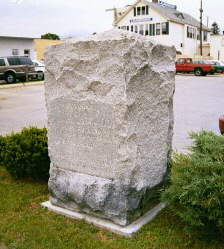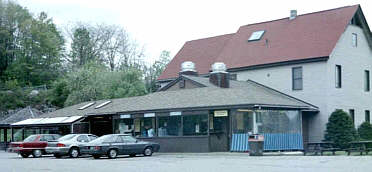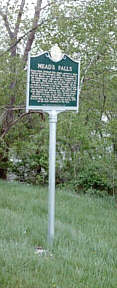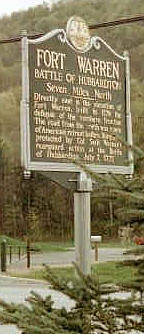RUTLANDVERMONT |
 |
RUTLANDVERMONT |
 |
|
Green Mountain Boys. Erected by the Ann Storey Chapter, Daughers of the American Revolution. 1915. |
The monument to the Green Mountain Boys is in the center of a beautiful, peaceful park, surrounded by flowers.
Like Manchester, Rutland was also a revolutionary crossroad for the Green Mountain Boys. Around May 7, 1775, it was visited by the patriot force consisting of:
Edward Mott and about 16 volunteers from Connecticut.
James Easton, John Brown and about 40 volunteers from the Berkshires.
Ethan Allen, Seth Warner and about 200 Green Mountain Boys.
The force marched through Rutland on their way to Castleton to make plans for the capture of Fort Ticonderoga.
On July 8, 1777, Rutland was a temporary safe-haven for Major General Arthur St. Clair and 2,500 retreating American troops. It would later be a refuge for the Green Mountain Boys who had escaped over the mountains from the Battle of Hubbardton.
 |
Fort Rutland 1775 Erected on the site of Fort Rutland by Ann Storey Chapter, Daughters of the American Revolution, June 14, 1901. |
Just up US Route 7 from the park is the intersection with US Route 4 Business. At the northeast corner of this busy intersection is a Fort Rutland marker.
 New Village Snack Bar -- a great local outdoor
restaurant for lunch. The menu includes some local specials like French
fries with gravy, whole belly clams, and several versions of their chicken
sandwich. The restaurant has picnic tables in a large picnic area in the back
with both covered and uncovered tables.
New Village Snack Bar -- a great local outdoor
restaurant for lunch. The menu includes some local specials like French
fries with gravy, whole belly clams, and several versions of their chicken
sandwich. The restaurant has picnic tables in a large picnic area in the back
with both covered and uncovered tables.
Otter Creek.
 |
Meade's Falls James Meade, Rutland's first settler arrived at these falls on the Otter Creek in 1769. The next year, he and his family were given shelter by members of the Caughnawag Tribe while they finished their log cabin. Meade built saw and gristmills on the falls and ran a ferry on the Otter Creek. He was an ardent defender of the New Hampshire Grants and served as a Colonel in the militia. Mead's falls was an important military site. The 1759 Crown Point Military Road ran by here. General Arthur St. Clair wrote his report after the Battle of Hubbardton in 1777 at Mead's home on the West Proctor Road and Fort Ranger was built in 1778 on the bluff northeast of the falls. |
Fort Warren Marker. Fort Warren stood on this site from 1777-1779. After the loss of Fort Ticonderoga and Mount Independence, Fort Rutland, Fort Ranger and Fort Warren were part of a string of forts for the defense of Vermont. North of these forts all the way to Canada became a demilitarized zone. Those that entered or remained in the area did so at their own risk.
 |
FORT WARREN Battle of Hubbardton Directly east is the elevation for Fort Warren built in 1779 for defense of the Northern Frontier. The road from the north was the route of American retreat before Burgoyne protected by Colonel Seth Warner's rear guard action at the Battle of Hubbardton, July 7, 1777. |
